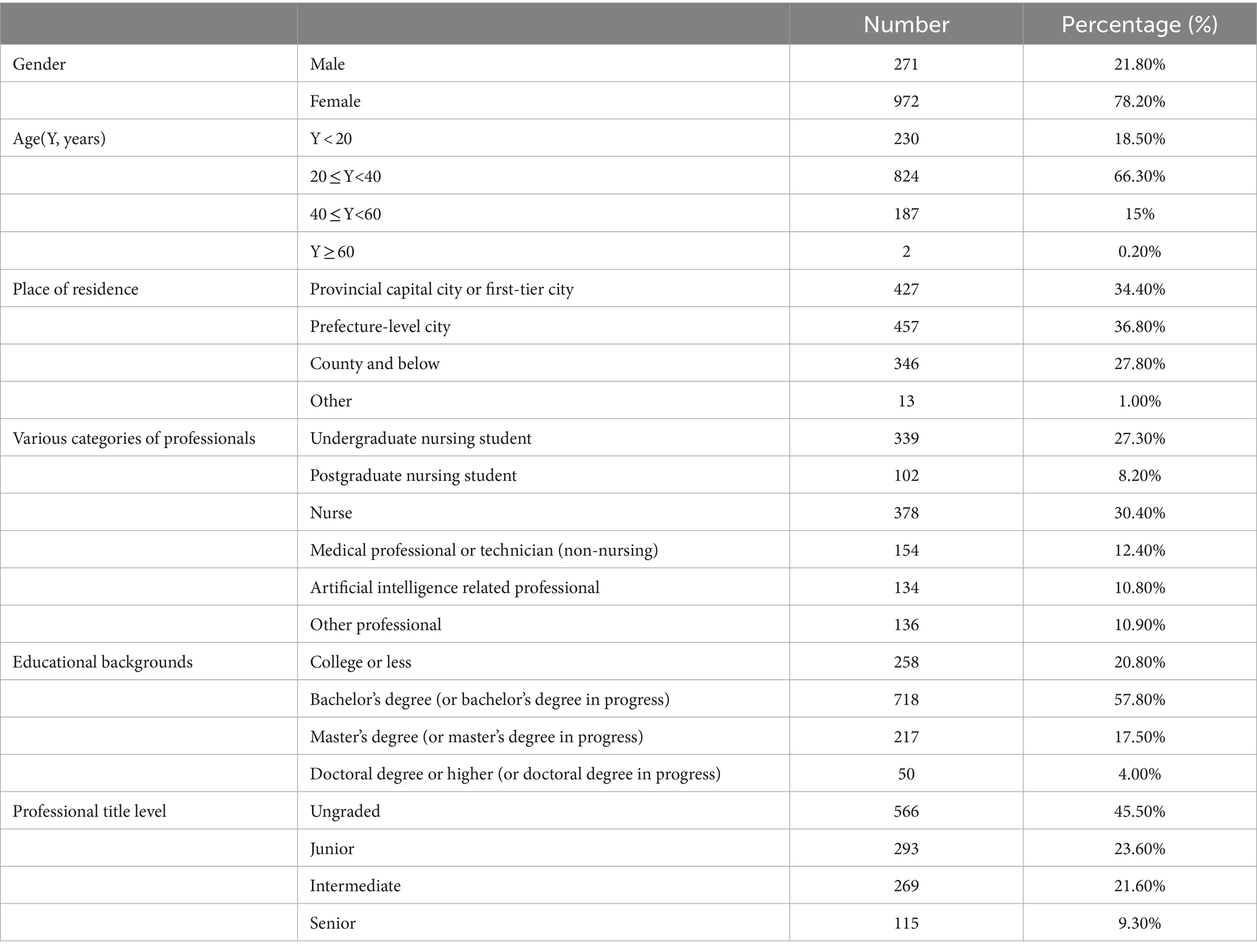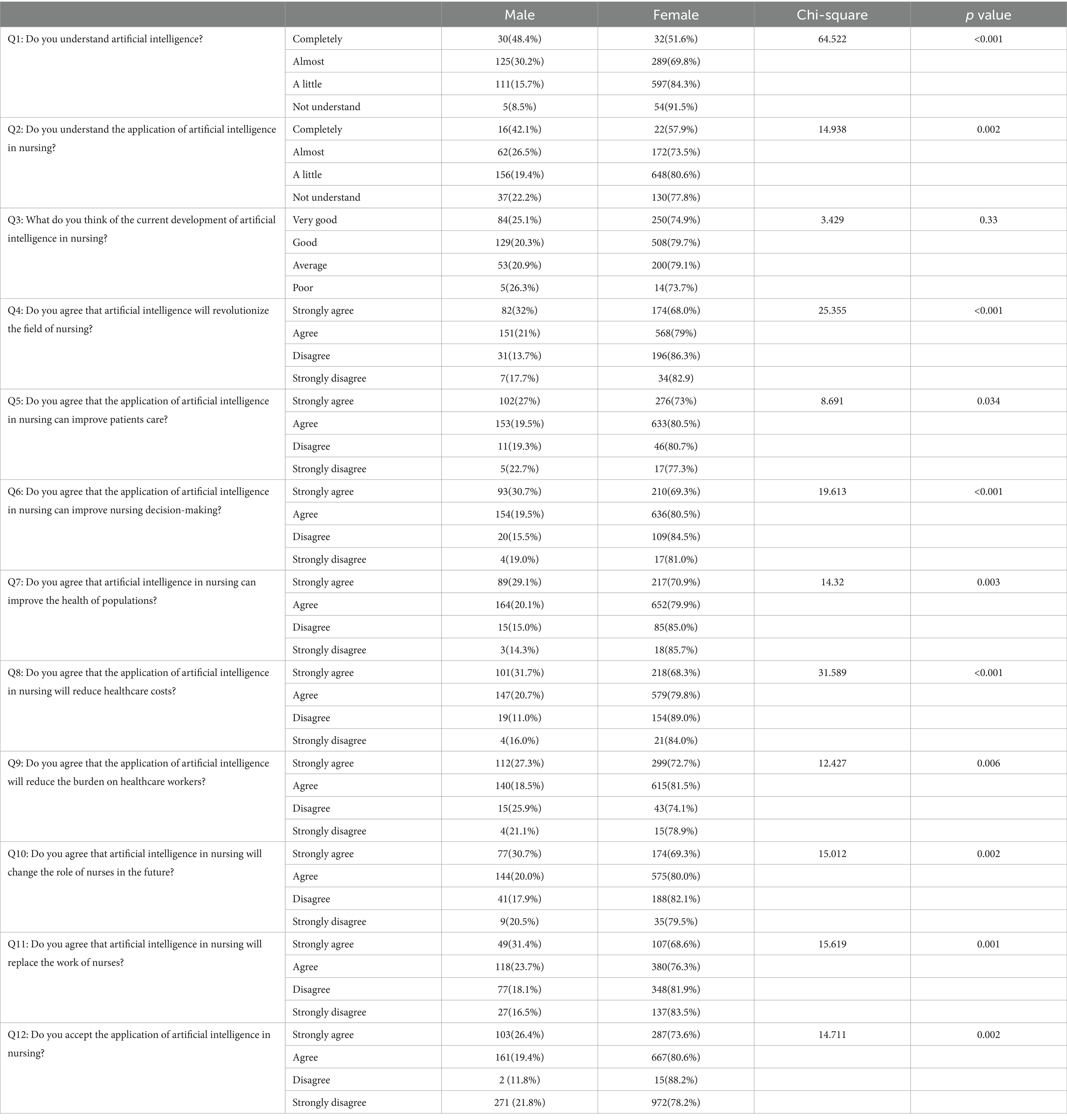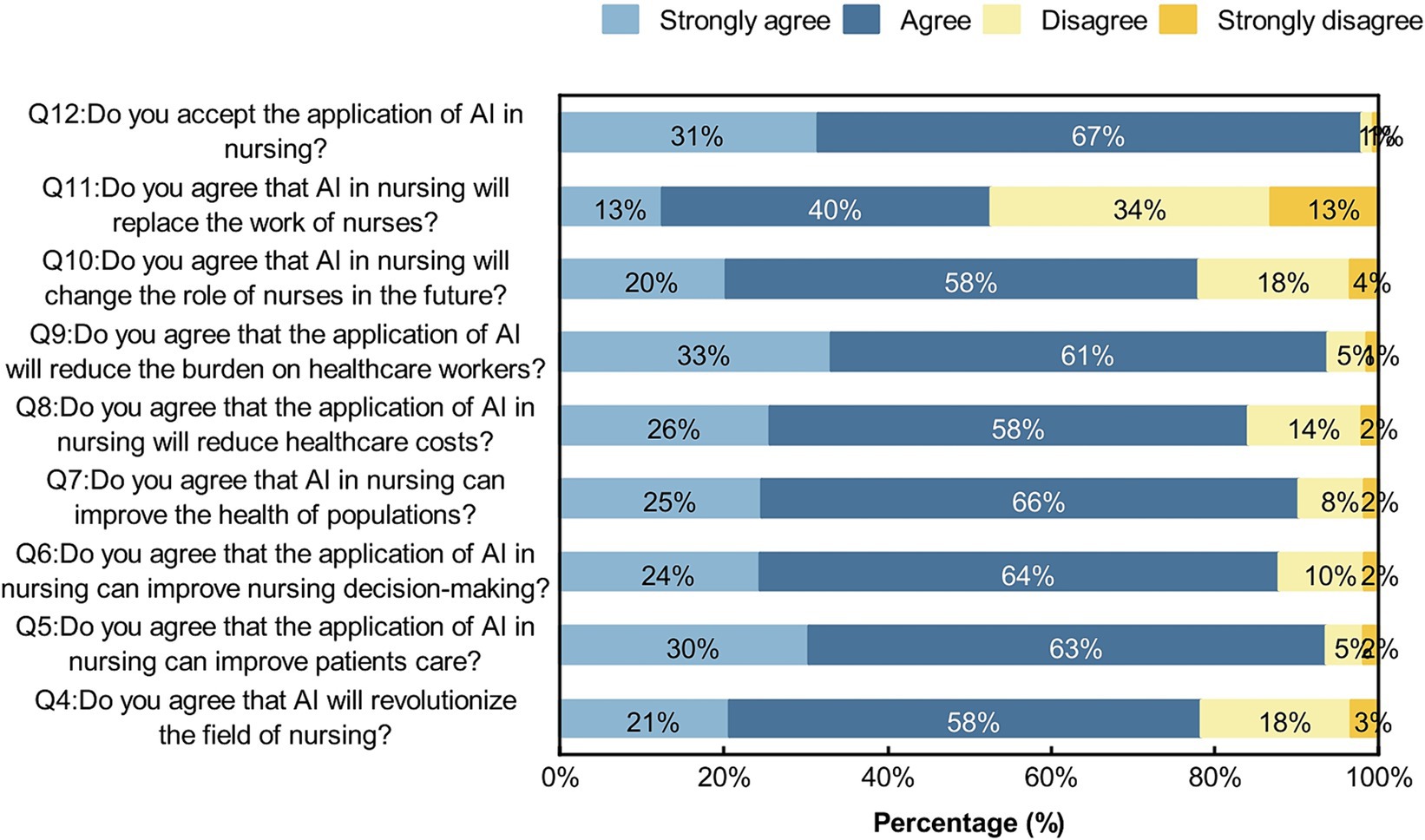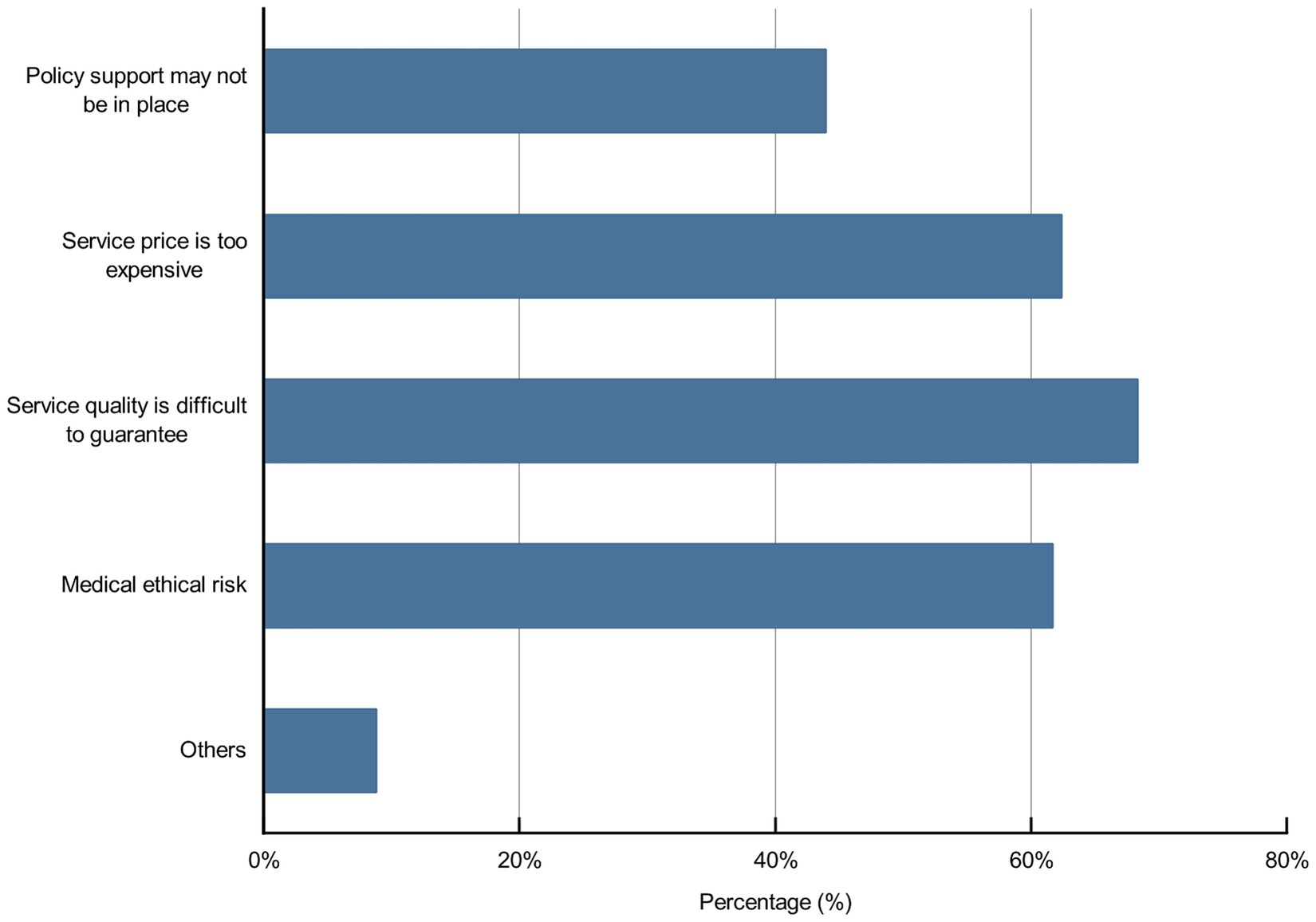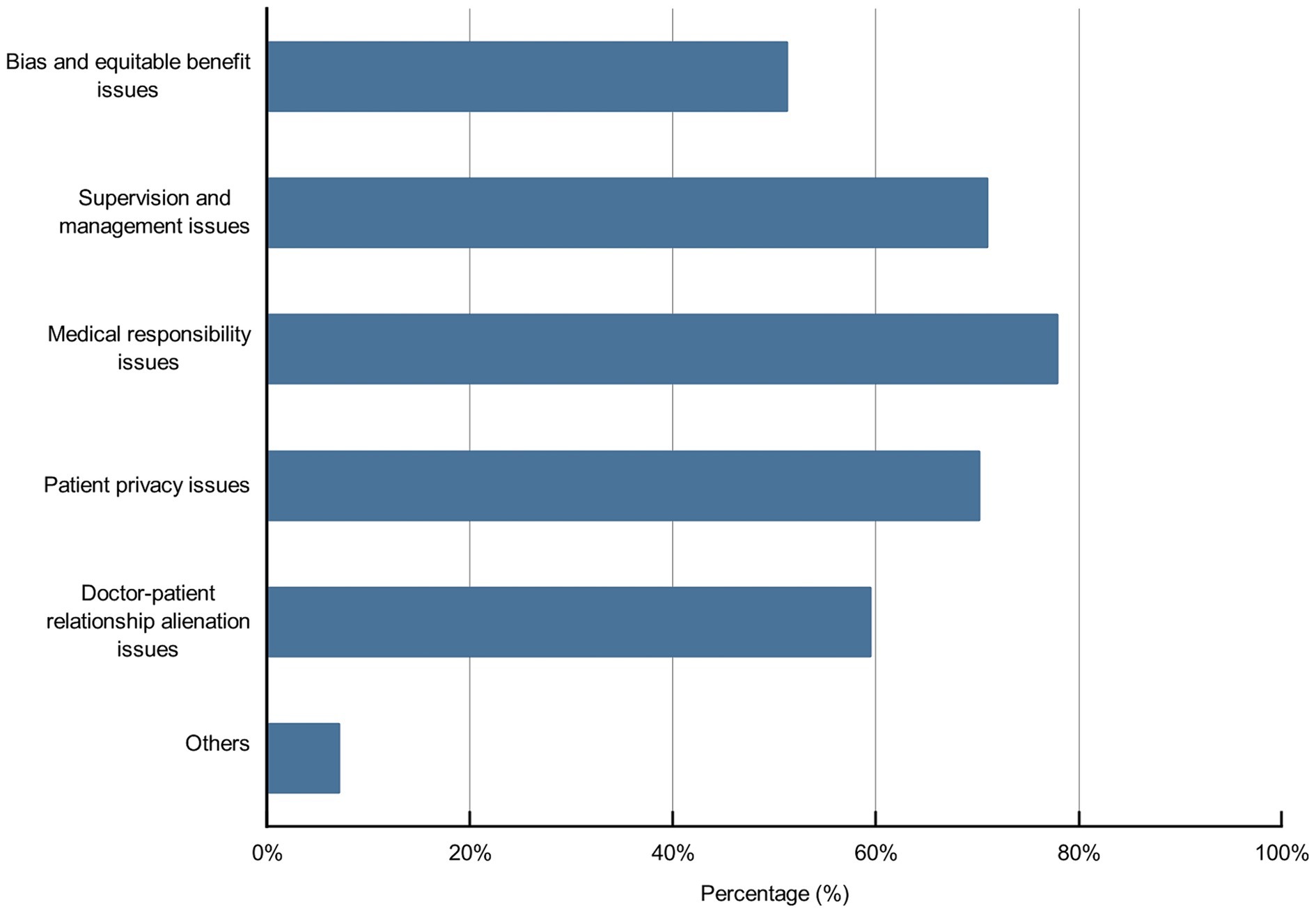- 1School of Nursing, Southwest Medical University, Luzhou, Sichuan Province, China
- 2Department of Ophthalmology, The Affiliated Hospital, Southwest Medical University, Luzhou, Sichuan, China
- 3Department of Nursing, First People’s Hospital of Huzhou, Huzhou University, Huzhou, Zhejiang Province, China
- 4Department of Nursing, Shenzhen Eye Institute, Shenzhen Eye Hospital, Jinan University, Shenzhen, Guangdong Province, China
Objectives: The application of artificial intelligence (AI) in healthcare is an important public health issue. However, few studies have investigated the perceptions and attitudes of healthcare professionals toward its applications in nursing. This study aimed to explore the knowledge, attitudes, and concerns of healthcare professionals, AI-related professionals, and others in China toward AI in nursing.
Methods: We conducted an online cross-sectional study on nursing students, nurses, other healthcare professionals, AI-related professionals, and others in China between March and April 2024. They were invited to complete a questionnaire containing 21 questions with four sections. The survey followed the principle of voluntary participation and was conducted anonymously. The participants could withdraw from the survey at any time during the study.
Results: This study obtained 1,243 valid questionnaires. The participants came from 25 provinces and municipalities in seven regions of China. Regarding knowledge of AI in nursing, 57% of the participants knew only a little about AI, 4.7% did not know anything about AI, 64.7% knew only a little about AI in nursing, and 13.4% did not know anything about AI in nursing. For attitudes toward AI in nursing, participants were positive about AI in nursing, with more than 50% agreeing and strongly agreeing with each question on attitudes toward AI in nursing. Differences in the numbers of participants with various categories of professionals regarding knowledge and attitudes toward AI in nursing were statistically significant (p < 0.05). Regarding concerns and ethical issues about AI in nursing, every participant expressed concerns about AI in nursing, and 95.7% of participants believed that it is necessary to strengthen medical ethics toward AI in nursing.
Conclusion: Nursing students and healthcare professionals lacked knowledge about AI or its application in nursing, but they had a positive attitude toward AI. It is necessary to strengthen medical ethics toward AI in nursing. The study’s findings could help develop new strategies benefiting healthcare.
1 Introduction
Artificial intelligence (AI) is a branch of computer science. It is an intelligent system that uses computer technology to simulate, extend, expand, and realize the human mind to carry out thinking activities, learn knowledge, etc., and to help human beings solve problems (1, 2). With the rapid development of the Internet and AI, the combination of AI and medicine has had far-reaching effects on healthcare systems and nursing (3–7). AI plays a significant role in clinical care, nursing education, nursing management, etc.
In clinical care, AI technology, especially AI robots, has a relatively wide range of applications throughout the entire process from patient admission to discharge, and even post-discharge home rehabilitation care. In busy hospital outpatient clinics, mobile intelligent guide robots play an important role in optimizing outpatient services, improving outpatient patient’s experience, and reducing the workload of nurses (8). In hospital intensive care unit, robots with different functions such as logistics and disinfection robots, rehabilitation assistance robots, and treatment assistance robots contribute to reduce the workload of nurses and provide personalized needs (9). When caring for infected patients undergoing isolation, nurses face the risk of infection at any time. The emergence of mobile robots not only reduces the risk of infection, but also improves the efficiency and quality of care (10). For discharged patients with disabilities or walking disabilities, compared with walking aids, mobility robots can sense the surrounding environment and the user’s intention, flexibly assisting walking and reducing the occurrence of adverse events (11, 12). Exoskeleton robots can help stroke patients improve their gait and facilitate their rehabilitation (13). In addition, socially assistive robots can promote social interactions among home-bound older adults, reduce their sense of loneliness, and enhance their sense of well-being (14).
Generative AI is more widely used in nursing education. Generative AI is a class of AI models including natural language processing, machine learning, reasoning and decision-making and other multi-disciplinary technologies, which can creatively generate images, text, phonetics, etc., and has a promising application in the field of nursing education. Currently, ChatGPT is one of the most powerful generative AI models, and its use not only meets the personalized learning needs of nursing students, but also improves the efficiency of teachers and promotes collaboration and communication between teachers and students (15). ChatGPT simulates learning environments or hospital scenarios for nursing students through virtual reality, which is conducive to improving the students’ confidence and learning ability (16, 17). In addition, ChatGPT can provide nursing students with timely learning feedback, meet the need for rapid access to information, and improve time management skills (18, 19).
Reducing the occurrence of adverse events such as falls and pressure injury in hospitals is an important part of nursing management. Based on AI algorithms such as machine learning that can process large amounts of data and construct predictive models with good performance, it can help nursing managers to formulate appropriate management plans, while nurses can effectively identify risk factors for pressure injury and falls, and formulate nursing care measures to address the risk factors to reduce the incidence rate (20, 21). In addition, predictive models based on machine learning algorithms have also been used to predict unplanned readmissions of patients and diseases to reduce healthcare-related costs through active intervention (22, 23).
Artificial intelligence’s application in nursing demonstrates its unique advantages. It can help optimize nursing procedures, improve nursing practice efficiency, and facilitate precision nursing (24). AI can efficiently analyze large amounts of complex data to help diagnose various medical conditions and reduce the workload of healthcare workers (25); disease risk prediction models built based on machine-learning algorithms can quickly identify diseases (26). Nevertheless, AI’s application in nursing has drawbacks and raises ethical issues (24).
Many countries have studied the perceptions and attitudes of medical students, healthcare professionals, and patients toward the use of AI in the medical field (27–30). Many studies have demonstrated positive attitudes toward AI; in contrast, controversial perceptions regarding AI have also been reported (31, 32). However, few studies have investigated the perceptions and attitudes of medical students and healthcare workers toward AI’s application in nursing and reported surveys on ethical research. Because the development of AI in nursing is still in its infancy, advantages and problems exist in the field. This study aimed to investigate the perceptions, attitudes, and concerns of nursing students and healthcare professionals on AI in nursing and their views on ethical research, which could provide insight into developing strategies for improving AI’s application in the nursing field.
2 Methods
2.1 Study design and participants
We conducted an online cross-sectional study involving nursing students, nurses, physicians, other professionals, and technicians in China from March to April 2024. The inclusion criteria were as follows: (a) voluntary participation in the study and (b) inclusion of undergraduate nursing students, graduate nursing students, nurses, physicians, AI-related professionals, other professionals, and technical staff. The exclusion criteria were as follows: (a) those who were not willing to participate in the study or who withdrew during the study, (b) those who filled out the questionnaire incompletely, and (c) participants aged <18.
The questionnaire developed for this study consisted of 21 questions. The sample size was 5–10 times the number of variables, and 126–252 participants were included, considering a 20% invalid sample rate. The study included 1,243 participants. Informed consent was obtained from all participants.
2.2 Questionnaire development
After reviewing the literature on AI knowledge and attitudes, we synthesized questionnaires with good reliability and validity (33–35). The questionnaire was initially developed in English and then translated into Chinese. Before distributing the questionnaire, we combined the suggestions of experts and pre-survey participants to modify and improve the questionnaire and finally generated the official questionnaire. This was followed by a pilot study in which the questionnaire was used to conduct an exploratory factor analysis of 50 participants to clarify its reliability and validity. The reliability analysis results of the questionnaire were expressed using Cronbach’а coefficient, and the validity analysis results were expressed using Kaiser-Meyer-Olkin (KMO) and Bartlett’s test of sphericity (36). The Cronbach’а coefficient of the attitude toward the Nursing AI part of the questionnaire was 0.860, indicating good reliability. The KMO value of the attitude toward the Nursing AI questionnaire was 0.768, and the significance of Bartlett’s test of sphericity was less than 0.001, indicating that attitudes toward AI in the nursing section of the questionnaire were suitable for factor analysis. Exploratory factor analysis using principal component analysis revealed that the loadings squared and variance accumulated at a factor number of two reached 65.79% with good interpretability. The rotated component matrix is shown in Appendix Table 1, which showed good structural validity of the questionnaire. The sections on knowledge, concerns, and ethical research about AI were not suitable for questionnaire reliability tests because of the small number of questions and the inclusion of multiple-choice questions. Therefore, only attitudes toward AI in nursing were tested for reliability and validity.
2.3 Data collection
The questionnaire contained 21 questions in four sections. The first part of the questionnaire consisted of sociodemographic information, including six questions on sex, birth year and month, place of residence, various categories of professionals, educational backgrounds, and professional title. The second part of the questionnaire was based on the knowledge of AI or AI in nursing. It contained three questions and was conducted using a four-point Likert classification. The third part of the questionnaire focused on attitudes toward AI in nursing and consisted of nine questions rated on a four-point Likert scale. The fourth part of the questionnaire, which concerned ethical reviews about AI in nursing, contained three questions: two multiple-choice questions and one single-choice question.
2.4 Procedure
This survey was based on the Questionnaire Star App (China’s professional questionnaire survey application), which is easy to edit and distribute. The purpose and significance of this survey were explained to the participants in detail before its release. The collected information will be used for academic research only. The survey followed the principle of voluntary participation and was conducted anonymously. The participants could withdraw from the study at any time during the survey. Snowball sampling was used for data collection. The data collected using the Questionnaire Star App were imported into Microsoft Excel 2021 for organization and analysis.
According to Article 3 of the Measures for Ethical Review of Biomedical Research Involving Humans issued by the National Health and Family Planning Commission in 2016, no ethical review was required for this study (35).
2.5 Statistical analyses
SPSS (version 27.0) was used for data analysis. Categorical variables were expressed as frequencies and percentages, and continuous variables were expressed as means and standard deviations. The correlation between the categorical variables was tested using the Chi-square test and ratio analysis, and a p value of less than 0.05 indicated statistical significance.
3 Results
From 1,277 participants who participated in the survey, we obtained 1,243 valid questionnaires (97.34%) and 34 invalid questionnaires where age did not meet the inclusion criteria. Participants came from 25 provinces and municipalities in seven regions in China, including Southwest China (Sichuan, Guizhou, Yunnan, and Chongqing), North China (Beijing, Tianjin, Hebei, and Shanxi), Northeast China (Jilin and Inner Mongolia Autonomous Region), East China (Shanghai, Jiangsu, Zhejiang, Anhui, Jiangxi, Shandong, and Fujian), Central China (Hubei and Henan), South China (Guangdong and Guangxi Zhuang Autonomous Region), and Northwest China (Shaanxi, Gansu, and Xinjiang Uygur Autonomous Region).
3.1 Socio-demographic characteristics
In this survey, females accounted for 78.2% of all participants; most participants were 20–40 years old, accounting for 66.34%. The largest numbers of participants included those who lived in prefecture-level cities (36.8%), nurses (30.4%) who were followed by undergraduate nursing students (27.3%), those with a Bachelor’s degree (57.8%), and those without a professional title (45.5%) (Table 1).
3.2 Knowledge of AI
Participants were not sufficiently aware of AI, and their knowledge of AI needed to be improved. Of the participants, 57% knew only a little about AI, 4.7% did not know anything about AI, 64.7% knew only a little about AI in nursing, and 13.4% did not know anything about AI in nursing; 26.9 and 51.2% of the participants believed that the application of AI to nursing is very good and good, respectively (Figure 1). We conducted chi-square test for gender, age, place of residence, various categories of professionals, educational backgrounds and professional title level, and the results showed that different genders, ages, place of residences, and various categories of professionals, educational backgrounds on the knowledge of AI and AI in nursing are all p values less than 0.05; the p values of different ages, place of residences, and educational backgrounds on the development trend of AI in nursing are less than 0.05, and the p values of different genders and categories of participants on the development trend of AI in nursing are greater than 0.05, as shown on Tables 2–6 and Figure 2. In addition, p values of different professional title level of nurses on the knowledge of AI and on the development trend of AI in nursing are greater than 0.05, as shown on (Table 7).
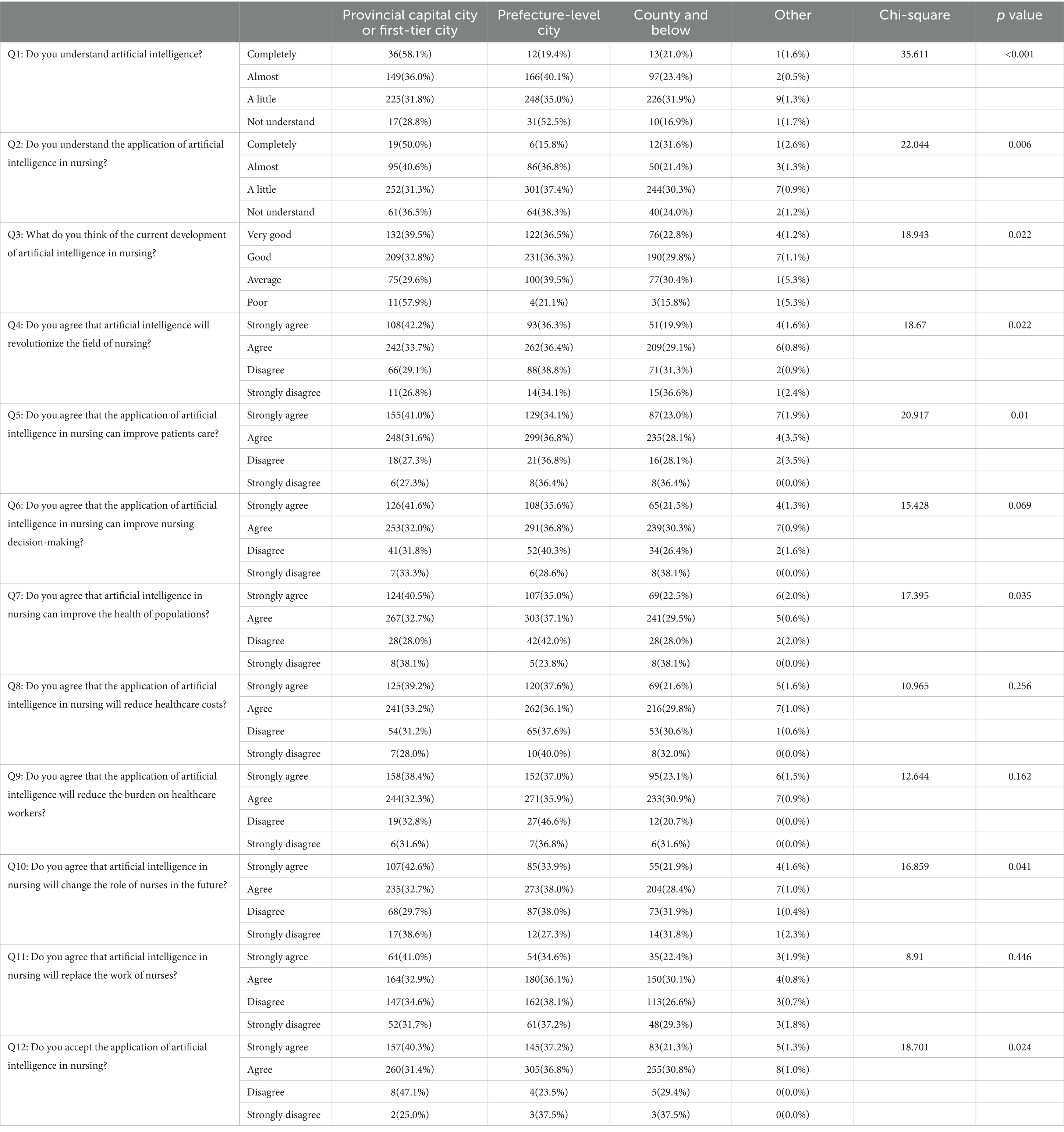
Table 4. Knowledge and attitudes toward AI in nursing among participants with different places of residence.
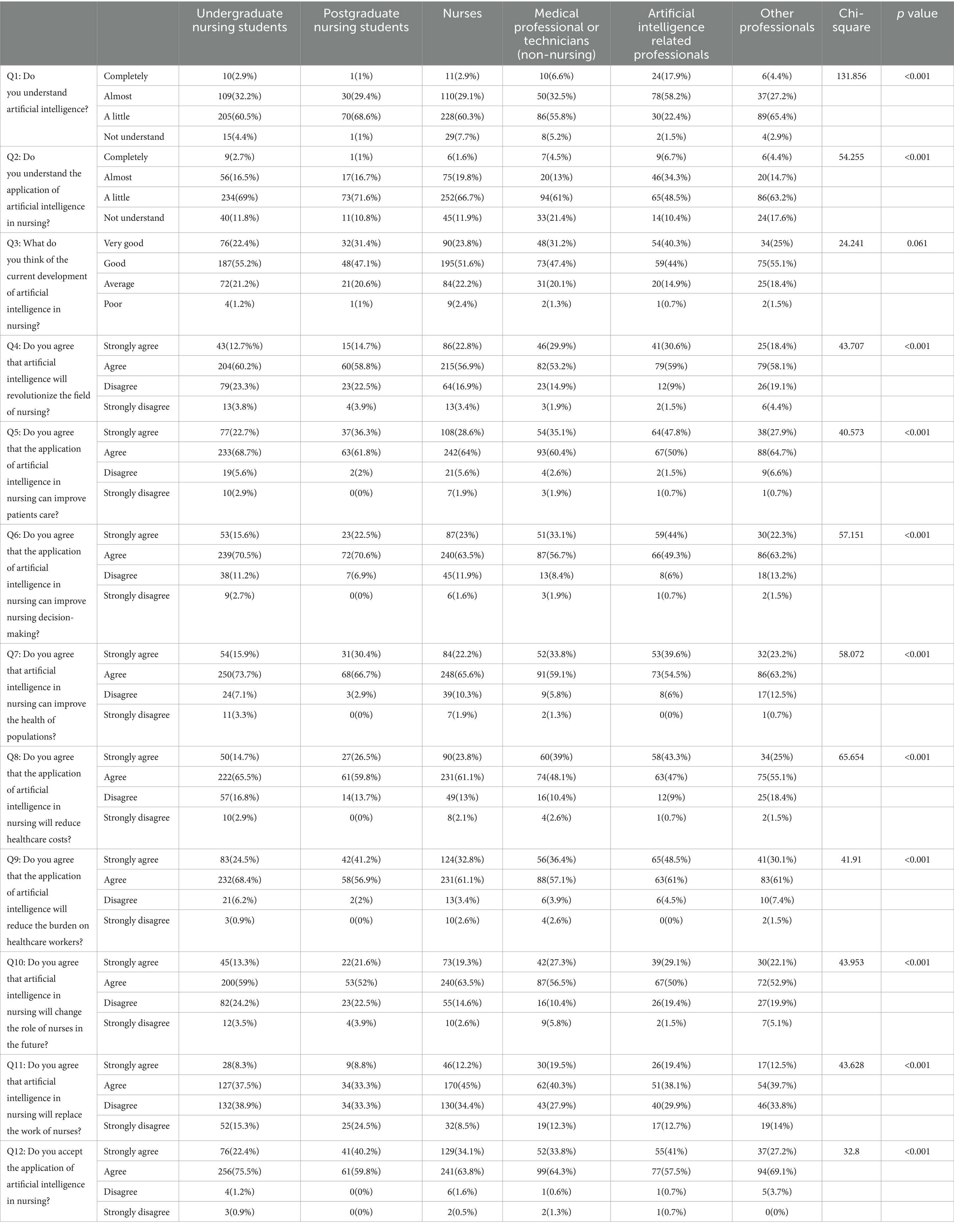
Table 5. Knowledge and attitudes toward AI in nursing among participants with various categories of professionals.
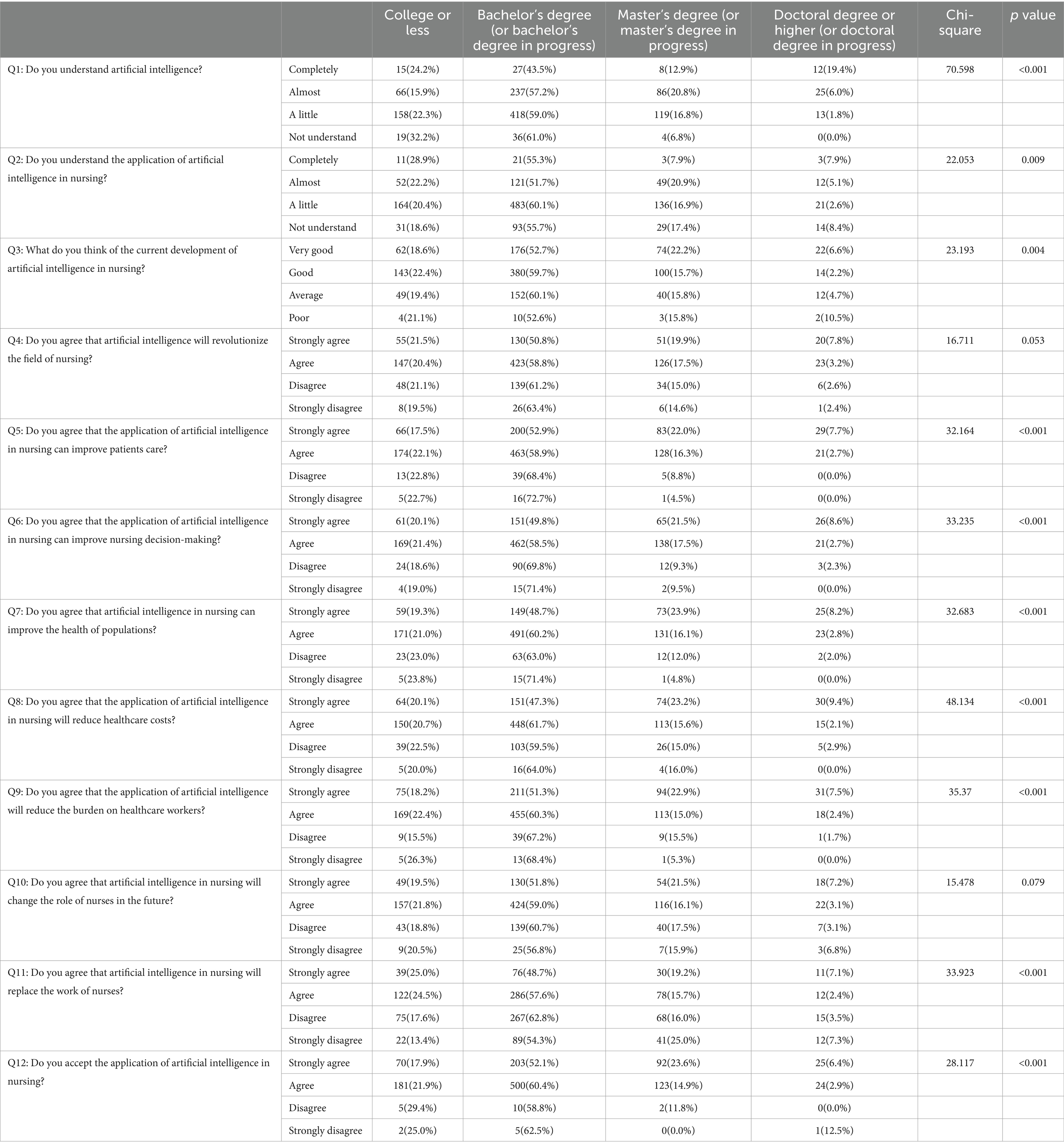
Table 6. Knowledge and attitudes toward AI in nursing across participants with varying educational backgrounds.
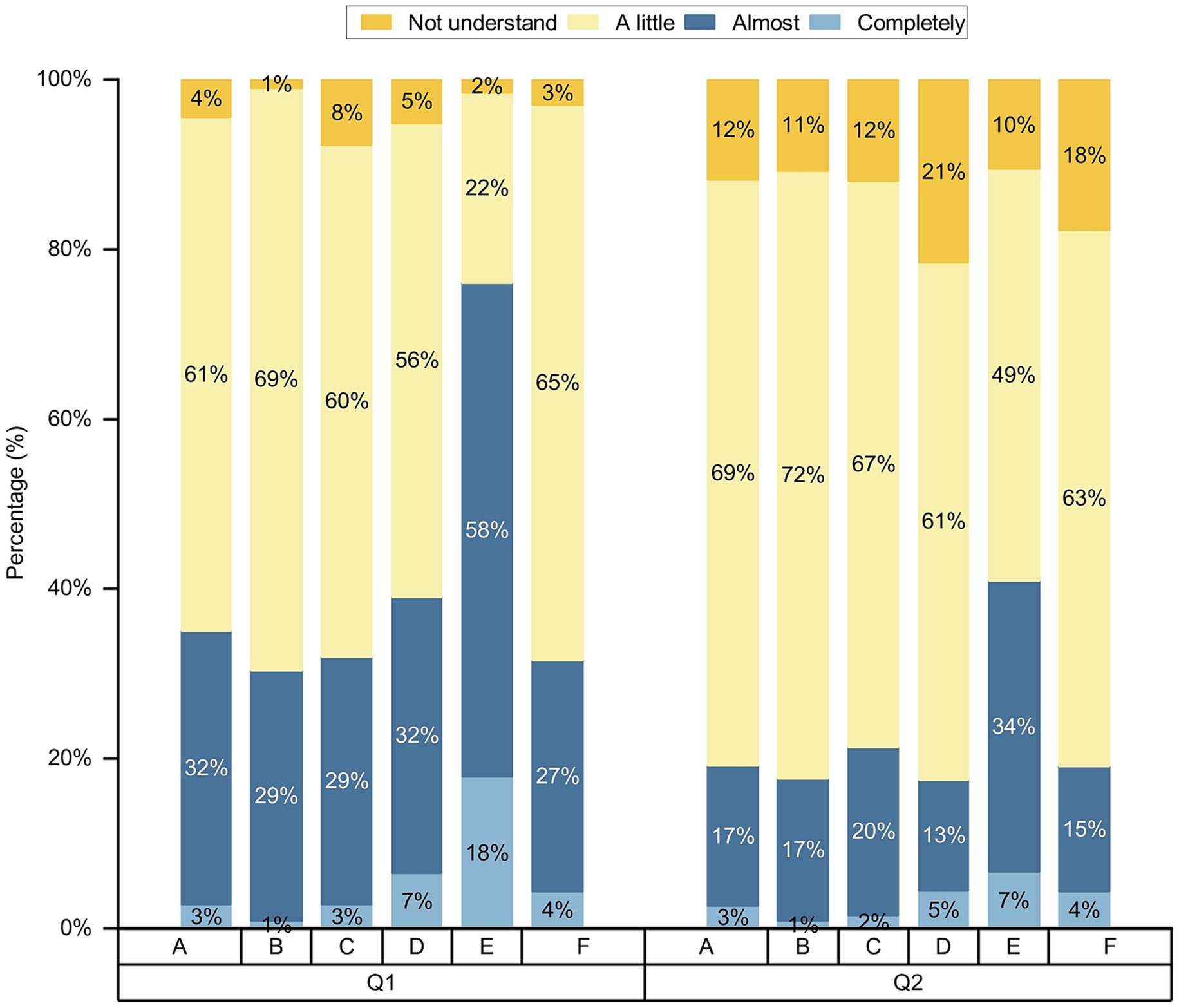
Figure 2. Comparison of differences in knowledge toward AI in nursing among participants with various categories of professionals. (A) Undergraduate nursing students; (B) postgraduate nursing students; (C) nurses; (D) other healthcare professionals; (E) AI-related professionals; and (F) other professionals; Q1-Q2, the questions of knowledge of AI in nursing.
3.3 Attitudes toward AI
Participants were positive about AI in nursing, with more than 50% agreeing and strongly agreeing with each question (Figure 3). We conducted chi-square test for gender, age, place of residence, various categories of professionals, educational backgrounds, and professional title level, and the results showed that the p values of different genders, ages, and various categories of professionals on the attitudes toward nursing AI were less than 0.05, while the p values of different place of residences and varying educational backgrounds on attitudes toward nursing AI part of the question were less than 0.05, as shown on Tables 2–6 and Figures 4–6. p values of nurses with different professional title level on attitudes toward nursing AI were all greater than 0.05, as shown on Table 7.
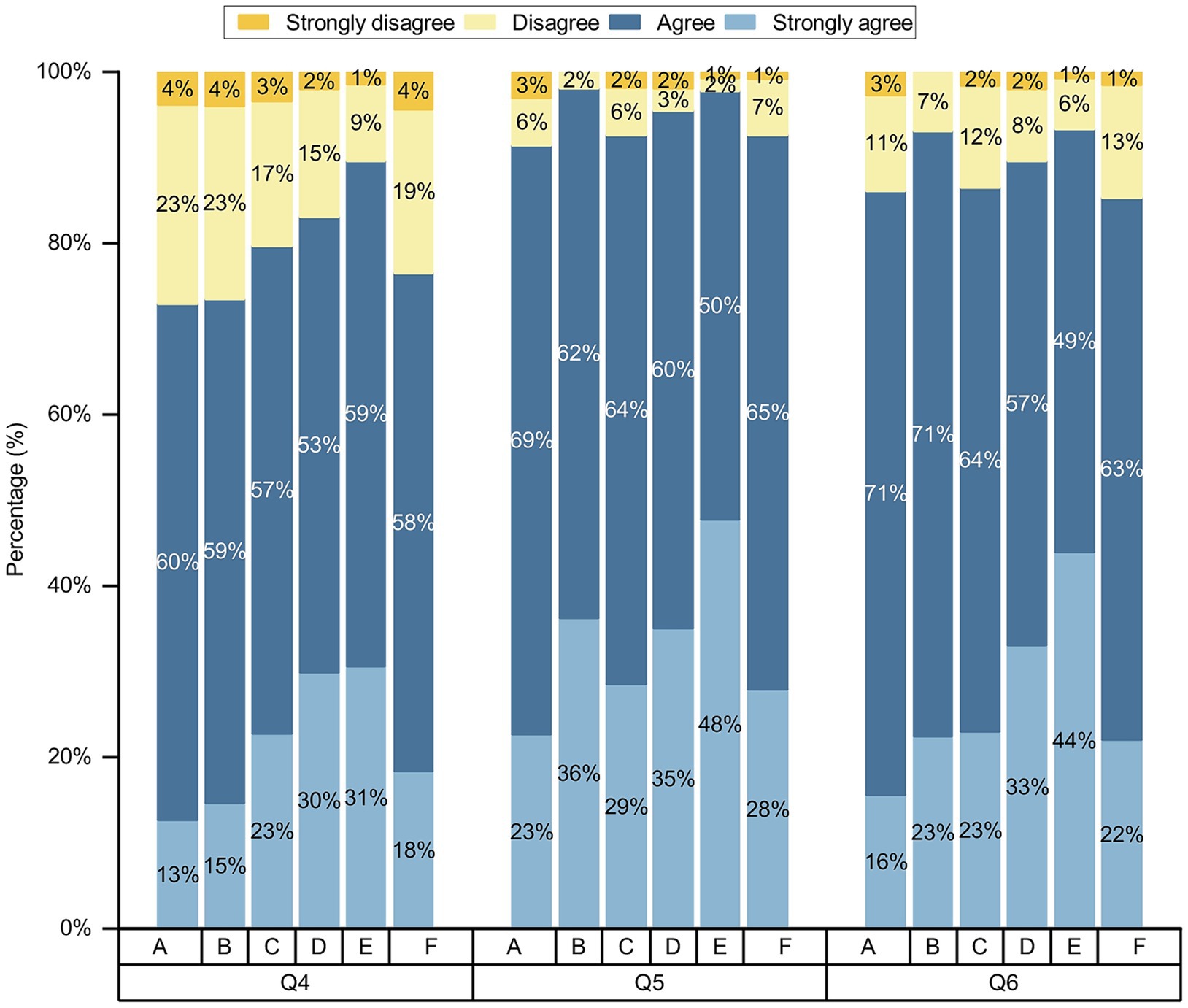
Figure 4. Comparison of differences in attitudes toward AI in nursing among participants with various categories of professionals. (A) Undergraduate nursing students; (B) postgraduate nursing students; (C) nurses; (D) other healthcare professionals; (E) AI-related professionals; and (F) other professionals; Q4–Q6, the questions of attitudes toward AI in nursing.
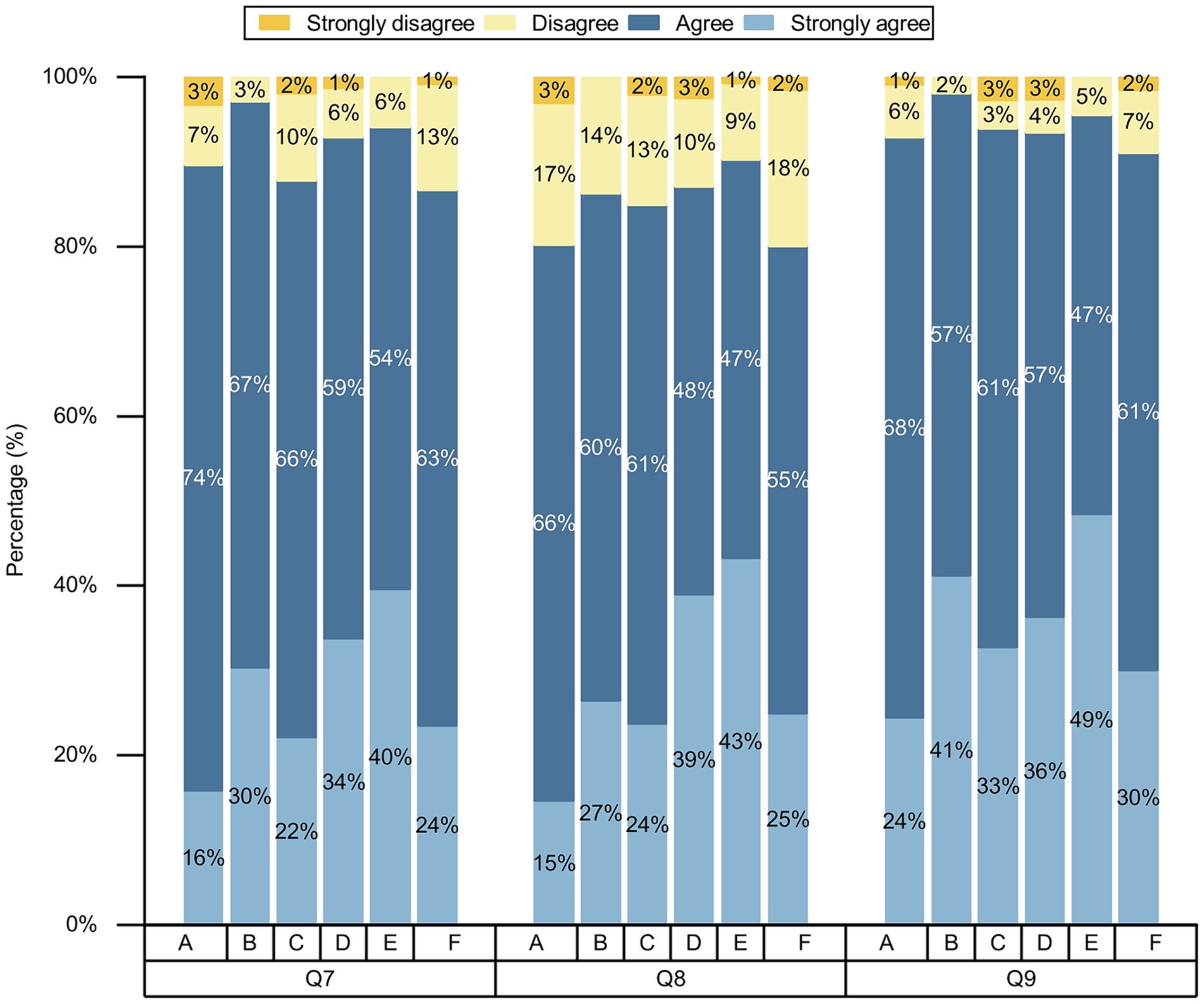
Figure 5. Comparison of differences in attitudes toward AI in nursing among participants with various categories of professionals. (A) Undergraduate nursing students; (B) postgraduate nursing students; (C) nurses; (D) other healthcare professionals; (E) AI-related professionals; and (F) other professionals; Q7–Q9, the questions of attitudes toward AI in nursing.
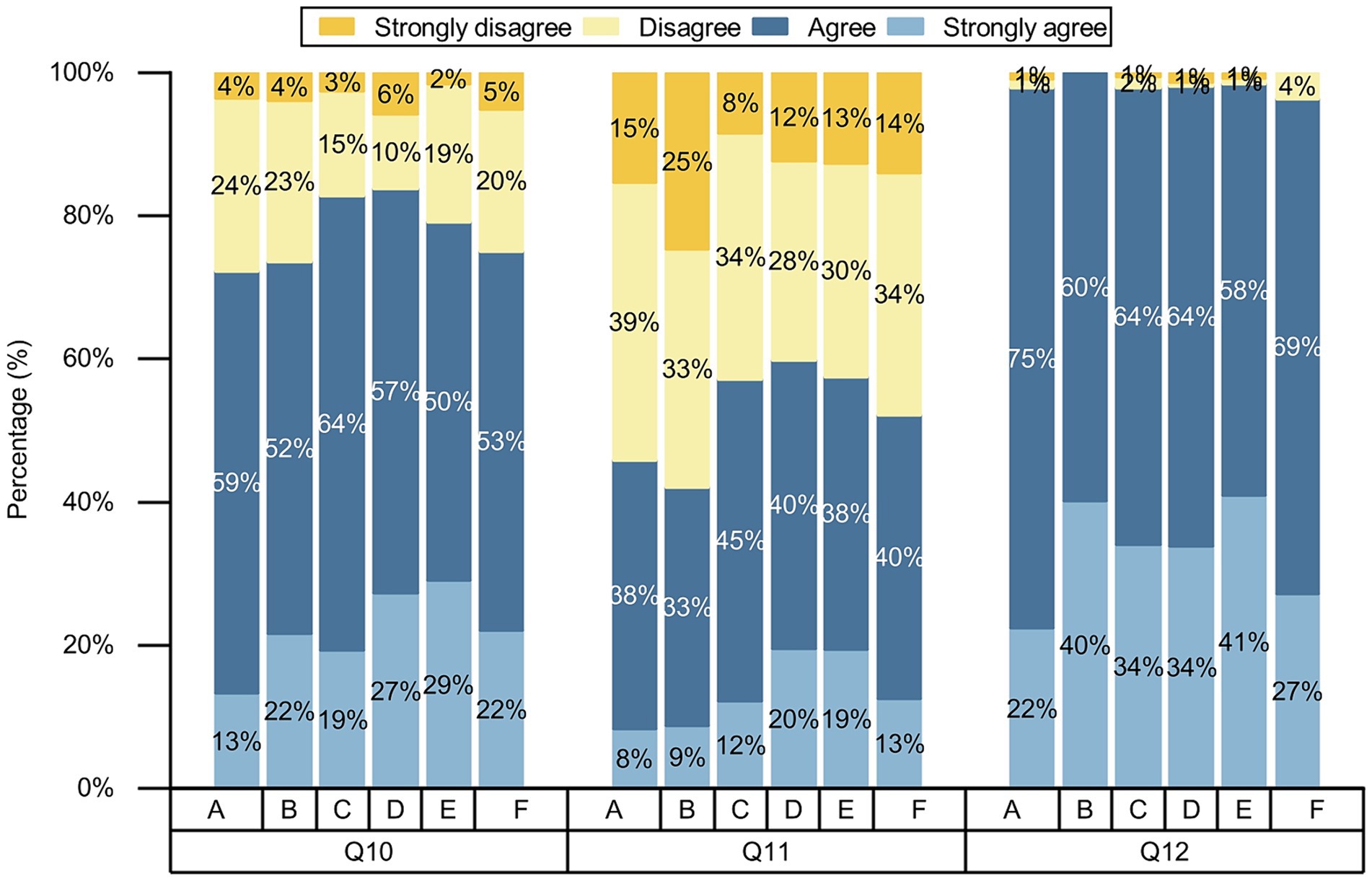
Figure 6. Comparison of differences in attitudes toward AI in nursing among participants with various categories of professionals. (A) Undergraduate nursing students; (B) postgraduate nursing students; (C) nurses; (D) other healthcare professionals; (E) AI-related professionals; and (F) other professionals; Q10–Q12, the questions of attitudes toward AI in nursing.
3.4 Concerns and ethical research about AI
Artificial intelligence in nursing may raise some concerns; 43.9, 62.3, 68.3, 61.7, and 8.8% of the participants, respectively, believed that policy support might not be in place, service price was too high, service quality was difficult to guarantee, medical ethical risk and others may hinder the development of AI in nursing (Figure 7). Moreover, 95.7% of participants believed that it was necessary to strengthen medical ethics toward AI in nursing; among these participants, 51.2, 71, 77.8, 70.2, 59.5, and 7.1% of the participants, respectively, believed that they should deal with bias and equitable benefit issues, supervision and management issues, medical responsibility issues, patient privacy issues, nurse–patient relationship alienation issues, and other issues (Figures 8, 9).
4 Discussion
This study explored the knowledge, attitudes, and concerns of undergraduate and postgraduate nursing students, nurses, other healthcare professionals, AI-related professionals, and others in China toward AI in nursing. It demonstrated that only a small percentage (38.3 vs. 21.9%) of the 1,243 participants completely or almost completely understood AI and AI in nursing. Most participants had positive attitudes toward AI in nursing. All participants reported concerns about AI in nursing, and 95.7% of the participants showed that it was necessary to perform ethical research on AI in nursing.
Our study shows that there are differences on knowledge of AI and AI in nursing by gender, age, place of residence, various categories of professionals, and educational backgrounds, and that there are differences on attitudes toward nursing AI by gender, age, and various categories of professionals, which is similar to the findings of Syed et al. (37) and Kansal et al. (38). However, similar study from Bahrain reported no correlations between the responses obtained and the age, gender or year of professional experience of the participants (29). This may be related to the high internet penetration in Bahrain and the younger age of the participants.
4.1 Knowledge of AI and AI in nursing
This study revealed that the participants had a low level of knowledge of AI and lacked knowledge of AI, particularly in nursing. Moreover, undergraduate nursing students, postgraduate nursing students, nurses, and other healthcare professionals significantly lacked knowledge of AI or AI in nursing compared with AI-related professionals. Our study showed that only 35.1% of undergraduate nursing students and 30.4% of postgraduate nursing students reported a complete or almost complete understanding of AI, and only 19.3% of undergraduate nursing students and 17.7% of graduate nursing students reported a complete or almost complete understanding of f AI’s application in nursing. This observation is consistent with previous studies that medical students in developing and developed countries have moderate or low levels of AI knowledge (32, 39–41). Significant differences were observed in the findings of Doumat et al. (42), Swed et al. (43), and Stewart (31), who showed that 59.7% of Lebanese medical students, 70% of Syrian medical students, and 84.8% of Western Australian medical students showed a good knowledge of AI and had a good understanding or possessed basic knowledge of AI, respectively. However, it was also revealed that most medical students reported little understanding of the basic computational principles of AI and AI’s application in medicine in their studies (31, 43). This study showed that only 32% of nurses and 39.1% of other healthcare professionals were completely or almost understood AI, and only 21.4% of nurses and 17.5% of healthcare professionals were completely or almost completely understood AI’s application in nursing, consistent with previous studies (44). In response to the general lack of awareness of AI among medical students and healthcare professionals, the level of awareness can be increased by incorporating AI into medical school curricula or by increasing AI-related training (45, 46).
4.2 Attitudes toward AI in nursing
Our study shows that there is little difference in the attitudes of different professionals and technicians toward the use of AI in nursing, which is generally optimistic. Most participants believed that using AI in nursing could improve patient care, population health, and nursing decisions and reduce the burden on healthcare professionals. Positive attitudes of nursing students and nurses toward AI are conducive to the development of AI in nursing. The more positive the attitude toward AI, the more it will help nursing students use AI technology in their future work and overcome potential barriers to AI technology (47). However, 53% of participants agreed or strongly agreed that AI would replace the jobs of nurses, inconsistent with the study by Moldt et al. (28), where most medical students did not believe that AI would replace their jobs. The survey by Castagno et al. (44) of Saudi Arabian healthcare workers also found that 72% of participants were not concerned that AI would replace their jobs. The reason for this discrepancy may be that the participants in this study lacked knowledge about AI and did not realize that AI technology has emerged to complement the work of healthcare workers and enhance their productivity rather than replace the work of nurses.
4.3 Nurses’ knowledge and attitudes toward AI in nursing
This study showed no differences in knowledge and attitudes toward AI in nursing among nurses with different job titles and generally less understanding of AI but positive attitudes. The lack of nurses’ understanding of AI may be due to several reasons. First, AI’s development in China’s nursing field is in its initial stage, and the application of AI technology in nursing is not yet well understood. Second, knowledge of AI technology often involves complex computer disciplines, and some AI algorithms exhibit the “black box” phenomenon, making AI technology difficult to understand (48). Third, due to the shortage of nurses in China, Chinese nurses working in hospitals are often physically and mentally exhausted because of their busy schedules and lack of time to learn AI (49). However, nurses had a positive attitude toward AI, which benefits the dissemination of AI-related knowledge and the application of AI technology.
In addition, healthcare professionals, especially nurses, are the main contributors to the promotion of AI in nursing, and their attitudes toward AI in nursing will, to a certain extent, affect the speed and quality of nursing AI development. However, our study showed no difference between nurses and other professionals in their attitudes toward AI in nursing and do not show significant advantages, so the popularization of AI knowledge among nurses should be strengthened to enhance the promotion of AI in the nursing field.
4.4 Concerns about AI in nursing
Although most participants were positive about the application of AI in nursing, all expressed concerns. Difficulty guaranteeing the quality of AI, being too expensive to use, many medical ethical issues, and the lack of policy support were the top four reasons hindering the application of AI in the nursing field. In China, AI technology is slowly integrating into nursing disciplines, and we need to fully understand the strengths and limitations of AI and address or improve these obstacles in practice to promote the development of the nursing field better.
4.5 Ethical issues
This study showed that 95.7% of the participants thought it necessary to strengthen medical ethics toward AI in nursing, where the first issue of attribution of medical responsibility was of great concern. Who is responsible for the medical errors when healthcare professionals use AI technology? However, this issue is controversial (50, 51). The second issue concerns the supervision and management of AI technology. In China, a supervision, management system and guidelines for AI have not been established, which may lead to the misuse of AI technology and loss of management control by healthcare administrators (24). Further, ethical issues regarding patient privacy and safety exist (52). AI technology requires a large amount of patient data, and the use of patient health-related data may involve personal information, resulting in patient privacy issues (24). In addition, using AI technology may lead to alienation of the nurse–patient relationship. Nursing is a discipline of humanistic care, and AI technology cannot communicate well with patients emotionally (53).
Regarding these ethical issues, healthcare professionals need to approach AI technology dialectically. They cannot do so without managers, research developers, and healthcare professionals continuing to improve AI technology or develop AI-related legal regimes to facilitate the development of AI in healthcare.
4.6 Strengths and limitations
This study had several strengths. First, to develop the questionnaire, we reviewed the relevant literature, conducted expert consultations, and performed a pilot study before starting the study to ensure its reliability and validity. This ensured the rigor of the study. Second, to make a good comparison, we surveyed six groups of people, compared their knowledge and attitudes toward AI in nursing, and analyzed and compared the differences. Third, few studies have investigated the ethical issues of AI; in contrast, this study investigated and discussed participants’ perceptions of ethical research on AI. Finally, this is the first study conducted in China on knowledge and attitudes toward AI in nursing, which lays the foundation for the development of AI in nursing.
This study also had limitations. First, we used the snowball sampling method, which might lead to information bias, affecting the generalization of the study’s findings. Second, this was a cross-sectional study and did not analyze the relationships between variables in depth. Further in-depth studies are required in the future.
5 Conclusion
The application of AI in healthcare is an important public health issue. This study showed that nursing students and healthcare professionals lacked knowledge about AI and its application in nursing but had a positive attitude toward AI overall. Due to this lack of knowledge, there is a need to include AI in medical students’ curricula or to add relevant training. The majority of participants believed that AI would replace nurses’ jobs, which might be related to their insufficient understanding of AI. Every participant expressed concerns about nursing AI, and the vast majority agreed on the need for medical ethics research on nursing AI. With the continuous development of AI in healthcare, it is essential for healthcare professionals to deepen their understanding of AI, accept it with an open and positive attitude, and use AI technology reasonably to solve clinical problems.
The study did not find that clinical nursing professionals had an advantage over non-clinical nursing personnel in terms of their knowledge, attitudes, and concerns about nursing AI. It is important to highlight that clinical nursing personnel are the primary drivers of research and practice in nursing AI. Their knowledge, attitudes, and concerns significantly impact the development and application of nursing AI. As challenges and ethical issues exist in using AI technology, healthcare professionals must approach AI technology dialectically. They cannot work independently of managers, researchers, developers, and other healthcare professionals if they are to continuously improve AI technology and develop AI-related legal systems to promote AI advancement in healthcare. The findings of this study could provide valuable insights for developing new strategies to enhance healthcare services.
Data availability statement
The raw data supporting the conclusions of this article will be made available by the authors, without undue reservation.
Author contributions
XW: Data curation, Formal analysis, Methodology, Writing – original draft. FF: Investigation, Writing – original draft, Conceptualization, Methodology. JW: Data curation, Investigation, Writing – original draft. MH: Formal analysis, Methodology, Writing – original draft. FX: Formal analysis, Investigation, Writing – original draft. JT: Formal analysis, Writing – original draft. YW: Project administration, Supervision, Writing – review & editing. JG: Project administration, Resources, Supervision, Writing – review & editing.
Funding
The author(s) declare that no financial support was received for the research, authorship, and/or publication of this article.
Acknowledgments
We extend our sincerest gratitude to all the professionals who participated in this research.
Conflict of interest
The authors declare that the research was conducted in the absence of any commercial or financial relationships that could be construed as a potential conflict of interest.
Publisher’s note
All claims expressed in this article are solely those of the authors and do not necessarily represent those of their affiliated organizations, or those of the publisher, the editors and the reviewers. Any product that may be evaluated in this article, or claim that may be made by its manufacturer, is not guaranteed or endorsed by the publisher.
Supplementary material
The Supplementary material for this article can be found online at: https://www.frontiersin.org/articles/10.3389/fpubh.2024.1433252/full#supplementary-material
References
1. Ah, S, and Ha, S. Artificial intelligence education and tools for medical and health informatics students: systematic review. JMIR Med Educ. (2020) 6:e19285. doi: 10.2196/19285
2. O'Connor, S, Gasteiger, N, Stanmore, E, Wong, DC, and Lee, JJ. Artificial intelligence for falls management in older adult care: a scoping review of nurses’ role. J Nurs Manag. (2022) 30:3787–801. doi: 10.1111/jonm.13853
3. Kulkarni, S, Seneviratne, N, Baig, MS, and Khan, AHA. Artificial intelligence in medicine: where are we now? Acad Radiol. (2020) 27:62–70. doi: 10.1016/j.acra.2019.10.001
4. Stewart, J, Sprivulis, P, and Dwivedi, G. Artificial intelligence and machine learning in emergency medicine. Emerg Med Austral. (2018) 30:870–4. doi: 10.1111/1742-6723.13145
5. Al, F, and Jc, K. Artificial intelligence powers digital medicine. NPJ Digit Med. (2018) 1:5. doi: 10.1038/s41746-017-0012-2
6. Cheng, JZ, Ni, D, Chou, YH, Qin, J, Tiu, CM, Chang, YC, et al. Computer-aided diagnosis with deep learning architecture: applications to breast lesions in US images and pulmonary nodules in CT scans. Sci Rep. (2016) 6:24454. doi: 10.1038/srep24454
7. Vaughn, J, Shaw, RJ, and Molloy, MA. A telehealth case study: the use of telepresence robot for delivering integrated clinical care. J Am Psychiatr Nurses Assoc. (2015) 21:431–2. doi: 10.1177/1078390315617037
8. Ma, AC, Meng, Z, and Ding, X. Performance review of intelligent guidance robot at the outpatient clinic setting. Cureus. (2021) 13:e16840. doi: 10.7759/cureus.16840
9. Li, Y, Wang, M, Wang, L, Cao, Y, Liu, Y, Zhao, Y, et al. Advances in the application of AI robots in critical care: scoping review. J Med Internet Res. (2024) 26:e54095. doi: 10.2196/54095
10. Yoo, HJ, Kim, EH, and Lee, H. Mobile robots for isolation-room hospital settings: a scenario-based preliminary study. Comput Struct Biotechnol J. (2024) 24:237–46. doi: 10.1016/j.csbj.2024.03.001
11. Sun, Y, Xiao, C, Chen, L, Chen, L, Lu, H, Wang, Y, et al. A review of intelligent walking support robots: aiding Sit-to-stand transition and walking. IEEE Trans Neural Syst Rehabil Eng. (2024) 32:1355–69. doi: 10.1109/TNSRE.2024.3379453
12. Zhao, D, Sun, X, Shan, B, Yang, Z, Yang, J, Liu, H, et al. Research status of elderly-care robots and safe human-robot interaction methods. Front Neurosci. (2023) 17:1291682. doi: 10.3389/fnins.2023.1291682
13. Yang, J, Gong, Y, Yu, L, Peng, L, Cui, Y, and Huang, H. Effect of exoskeleton robot-assisted training on gait function in chronic stroke survivors: a systematic review of randomised controlled trials. BMJ Open. (2023) 13:e074481. doi: 10.1136/bmjopen-2023-074481
14. Nichol, B, McCready, J, Erfani, G, Comparcini, D, Simonetti, V, Cicolini, G, et al. Exploring the impact of socially assistive robots on health and wellbeing across the lifespan: an umbrella review and meta-analysis. Int J Nurs Stud. (2024) 153:104730. doi: 10.1016/j.ijnurstu.2024.104730
15. Ni, Z, Peng, R, Zheng, X, and Xie, P. Embracing the future: integrating ChatGPT into China’s nursing education system. Int J Nurs Sci. (2024) 11:295–9. doi: 10.1016/j.ijnss.2024.03.006
16. Abujaber, AA, Abd-alrazaq, A, al-Qudimat, AR, and Nashwan, AJ. A strengths, weaknesses, opportunities, and threats (SWOT) analysis of ChatGPT integration in nursing education: a narrative review. Cureus. (2023) 15:e48643. doi: 10.7759/cureus.48643
17. Mk, C, and My, K. Enhancing nursing competency through virtual reality simulation among nursing students: a systematic review and meta-analysis. Front Med. (2024). 11:1351300. doi: 10.3389/fmed.2024.1351300
18. Berşe, S, Akça, K, Dirgar, E, and Kaplan Serin, E. The role and potential contributions of the artificial intelligence language model ChatGPT. Ann Biomed Eng. (2024) 52:130–3. doi: 10.1007/s10439-023-03296-w
19. Alexandre, C, Pamela, F, Shauna, D, Laura, V, Manal, K, Tracie, R, et al. Revolutionizing nursing education through Ai integration: A reflection on the disruptive impact of ChatGPT. Nurse Educ Today. (2023) 129:105916. doi: 10.1016/j.nedt.2023.105916
20. D’Ambrosio, F, Harbo, M, Contiero, D, Bonfigli, AR, Cicconi, D, Heuer, N, et al. Preact to lower the risk of falling by customized rehabilitation across Europe: the feasibility study protocol of the PRECISE project in Italy. Front Public Health. (2024) 12:1293621. doi: 10.3389/fpubh.2024.1293621
21. Padula, WV, Armstrong, DG, Pronovost, PJ, and Saria, S. Predicting pressure injury risk in hospitalised patients using machine learning with electronic health records: a US multilevel cohort study. BMJ Open. (2024) 14:e082540. doi: 10.1136/bmjopen-2023-082540
22. Digumarthi, V, Amin, T, Kanu, S, Mathew, J, Edwards, B, Peterson, LA, et al. Preoperative prediction model for risk of readmission after total joint replacement surgery: a random forest approach leveraging NLP and unfairness mitigation for improved patient care and cost-effectiveness. J Orthop Surg. (2024) 19:287. doi: 10.1186/s13018-024-04774-0
23. Gong, D, Chen, X, Yang, L, Zhang, Y, Zhong, Q, Liu, J, et al. From normal population to prediabetes and diabetes: study of influencing factors and prediction models. Front Endocrinol. (2023) 14:1225696. doi: 10.3389/fendo.2023.1225696
24. Lee, D, and Yoon, SN. Application of artificial intelligence-based Technologies in the Healthcare Industry: opportunities and challenges. Int J Environ Res Public Health. (2021) 18:271. doi: 10.3390/ijerph18010271
25. Abdullah, R, and Fakieh, B. Health care employees’ perceptions of the use of artificial intelligence applications: survey study. J Med Internet Res. (2020) 22:e17620. doi: 10.2196/17620
26. Davoudi, A, Malhotra, KR, Shickel, B, Siegel, S, Williams, S, Ruppert, M, et al. Intelligent ICU for autonomous patient monitoring using pervasive sensing and deep learning. Sci Rep. (2019) 9:8020. doi: 10.1038/s41598-019-44004-w
27. Fritsch, SJ, Blankenheim, A, Wahl, A, Hetfeld, P, Maassen, O, Deffge, S, et al. Attitudes and perception of artificial intelligence in healthcare: a cross-sectional survey among patients. Digit Health. (2022) 8:205520762211167. doi: 10.1177/20552076221116772
28. Moldt, J-A, Festl-Wietek, T, Madany Mamlouk, A, Nieselt, K, Fuhl, W, and Herrmann-Werner, A. Chatbots for future docs: exploring medical students’ attitudes and knowledge towards artificial intelligence and medical chatbots. Med Educ. (2023) 28:2182659. doi: 10.1080/10872981.2023.2182659
29. Al-Medfa, MK, Al-Ansari, AMS, Darwish, AH, Qreeballa, TA, and Jahrami, H. Physicians’ attitudes and knowledge toward artificial intelligence in medicine: benefits and drawbacks. Heliyon. (2023) 9:e14744. doi: 10.1016/j.heliyon.2023.e14744
30.
31. Stewart, J, Lu, J, Gahungu, N, Goudie, A, Fegan, PG, Bennamoun, M, et al. Western Australian medical students’ attitudes towards artificial intelligence in healthcare. PLoS One. (2023) 18:e0290642. doi: 10.1371/journal.pone.0290642
32. Allam, AH, Eltewacy, NK, Alabdallat, YJ, Owais, TA, Salman, S, and Ebada, MA. Knowledge, attitude, and perception of Arab medical students towards artificial intelligence in medicine and radiology: a multi-national cross-sectional study. Eur Radiol (2023). doi: 10.1007/s00330-023-10509-2 (Epub ahead of print).
33. Shinners, L, Grace, S, Smith, S, Stephens, A, and Aggar, C. Exploring healthcare professionals’ perceptions of artificial intelligence: piloting the Shinners artificial intelligence perception tool. Digit Health. (2022) 8:205520762210781. doi: 10.1177/20552076221078110
34. Grassini, S . Development and validation of the AI attitude scale (AIAS-4): a brief measure of general attitude toward artificial intelligence. Front Psychol. (2023) 14:1191628. doi: 10.3389/fpsyg.2023.1191628
35. Zheng, B, Wu, M, Zhu, S, Zhou, H, Hao, X, Fei, F, et al. Attitudes of medical workers in China toward artificial intelligence in ophthalmology: a comparative survey. BMC Health Serv Res. (2021) 21:1067. doi: 10.1186/s12913-021-07044-5
36. Hinkin, TR . A brief tutorial on the development of measures for use in survey questionnaires. Organ Res Methods. (1998) 1:104–21. doi: 10.1177/109442819800100106
37. Syed, W, Basil, A, and Al-Rawi, M. Assessment of awareness, perceptions, and opinions towards artificial intelligence among healthcare students in Riyadh, Saudi Arabia. Medicina. (2023) 59:828. doi: 10.3390/medicina59050828
38. Kansal, R, Bawa, A, Bansal, A, Trehan, S, Goyal, K, Goyal, N, et al. Differences in knowledge and perspectives on the usage of artificial intelligence among doctors and medical students of a developing country: a cross-sectional study. Cureus. (2022) 14:e21434. doi: 10.7759/cureus.21434
39. Truong, NM, Vo, TQ, Tran, HTB, Nguyen, HT, and Pham, VNH. Healthcare students’ knowledge, attitudes, and perspectives toward artificial intelligence in the southern Vietnam. Heliyon. (2023) 9:e22653. doi: 10.1016/j.heliyon.2023.e22653
40. Sit, C, Srinivasan, R, Amlani, A, Muthuswamy, K, Azam, A, Monzon, L, et al. Attitudes and perceptions of UK medical students towards artificial intelligence and radiology: a multicentre survey. Insights Imag. (2020) 11:14. doi: 10.1186/s13244-019-0830-7
41. Hamedani, Z, Moradi, M, Kalroozi, F, Manafi Anari, A, Jalalifar, E, Ansari, A, et al. Evaluation of acceptance, attitude, and knowledge towards artificial intelligence and its application from the point of view of physicians and nurses: a provincial survey study in Iran: a cross-sectional descriptive-analytical study. Health Sci Rep. (2023) 6:e1543. doi: 10.1002/hsr2.1543
42. Doumat, G, Daher, D, Ghanem, N-N, and Khater, B. Knowledge and attitudes of medical students in Lebanon toward artificial intelligence: a national survey study. Front Artif Intellig. (2022) 5:1015418. doi: 10.3389/frai.2022.1015418
43. Swed, S, Alibrahim, H, Elkalagi, NKH, Nasif, MN, Rais, MA, Nashwan, AJ, et al. Knowledge, attitude, and practice of artificial intelligence among doctors and medical students in Syria: a cross-sectional online survey. Front Artif Intellig. (2022) 5:1011524. doi: 10.3389/frai.2022.1011524
44. Castagno, S, and Khalifa, M. Perceptions of artificial intelligence among healthcare staff: a qualitative survey study. Front Artif Intellig. (2020) 3:578983. doi: 10.3389/frai.2020.578983
45. Amiri, H, Peiravi, S, rezazadeh shojaee, S, Rouhparvarzamin, M, Nateghi, MN, Etemadi, MH, et al. Medical, dental, and nursing students’ attitudes and knowledge towards artificial intelligence: a systematic review and meta-analysis. BMC Med Educ. (2024) 24:412. doi: 10.1186/s12909-024-05406-1
46. Sommer, D, Schmidbauer, L, and Wahl, F. Nurses’ perceptions, experience and knowledge regarding artificial intelligence: results from a cross-sectional online survey in Germany. BMC Nurs. (2024) 23:205. doi: 10.1186/s12912-024-01884-2
47. Labrague, LJ, Aguilar-Rosales, R, Yboa, BC, Sabio, JB, and De Los Santos, JA. Student nurses’ attitudes, perceived utilization, and intention to adopt artificial intelligence (AI) technology in nursing practice: a cross-sectional study. Nurse Educ Pract. (2023) 73:103815. doi: 10.1016/j.nepr.2023.103815
48. Bz, W, Fg, D, and Mm, W. Exploring the opportunities and challenges of implementing artificial intelligence in healthcare: a systematic literature review. Urol Oncol. (2024) 42:48–56. doi: 10.1016/j.urolonc.2023.11.019
49. Yu, W, Zhang, Y, Xianyu, Y, and Cheng, D. Stressors, emotions, and social support systems among respiratory nurses during the omicron outbreak in China: a qualitative study. BMC Nurs. (2024) 23:188. doi: 10.1186/s12912-024-01856-6
50. Murphy, K, Di Ruggiero, E, Upshur, R, Willison, DJ, Malhotra, N, Cai, JC, et al. Artificial intelligence for good health: a scoping review of the ethics literature. BMC Med Ethics. (2021) 22:14. doi: 10.1186/s12910-021-00577-8
51. Bærøe, K, Gundersen, T, Henden, E, and Rommetveit, K. Can medical algorithms be fair? Three ethical quandaries and one dilemma. BMJ Health Care Inform. (2022) 29:e100445. doi: 10.1136/bmjhci-2021-100445
52. Hobensack, M, von Gerich, H, Vyas, P, Withall, J, Peltonen, LM, Block, LJ, et al. A rapid review on current and potential uses of large language models in nursing. Int J Nurs Stud. (2024) 154:104753. doi: 10.1016/j.ijnurstu.2024.104753
Keywords: artificial intelligence, nursing, knowledge, attitude, concern, ethic
Citation: Wang X, Fei F, Wei J, Huang M, Xiang F, Tu J, Wang Y and Gan J (2024) Knowledge and attitudes toward artificial intelligence in nursing among various categories of professionals in China: a cross-sectional study. Front. Public Health. 12:1433252. doi: 10.3389/fpubh.2024.1433252
Edited by:
Peter Kokol, University of Maribor, SloveniaReviewed by:
Jernej Zavrsnik, Health Center dr. Adolf Drolc, SloveniaXianlong Zeng, Ohio University, United States
Copyright © 2024 Wang, Fei, Wei, Huang, Xiang, Tu, Wang and Gan. This is an open-access article distributed under the terms of the Creative Commons Attribution License (CC BY). The use, distribution or reproduction in other forums is permitted, provided the original author(s) and the copyright owner(s) are credited and that the original publication in this journal is cited, in accordance with accepted academic practice. No use, distribution or reproduction is permitted which does not comply with these terms.
*Correspondence: Jinhua Gan, MTYwMzcxNzMxMEBxcS5jb20=;Yaping Wang, MTg3MDk0ODM5N0BxcS5jb20=
†These authors have contributed equally to this work and share first authorship
 Xiaoyan Wang
Xiaoyan Wang Fangqin Fei
Fangqin Fei Jiawen Wei
Jiawen Wei Mingxue Huang
Mingxue Huang Fengling Xiang
Fengling Xiang Jing Tu
Jing Tu Yaping Wang
Yaping Wang Jinhua Gan
Jinhua Gan